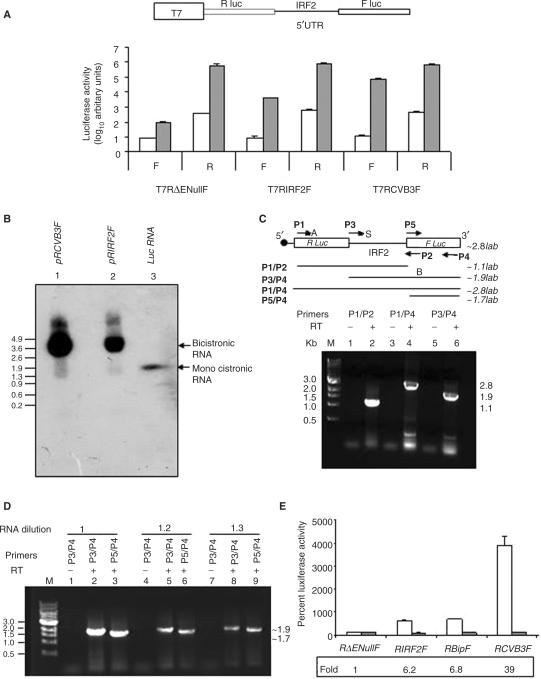Figure 2.
IRF2 bicistronic plasmid does not show cryptic promoter or splicing activity. (A) Bicistronic plasmid constructs pT7RΔEnullF or pT7RIRF2F or pT7RCVB3F were transfected in HeLa cells in the absence or presence of infection by recombinant vaccinia virus VTF7.3. FLuc activity and RLuc activity were measured and plotted as arbitrary values of log10 separately as indicated. The white bars indicate control (without vaccinia treatment) and the gray bars represent values under vaccinia-treated conditions. The data mean ± SD from three independent experiments. Schematic representation of bicistronic plasmid used in transient transfections is shown above the panel. (B) Northern blot of total RNA extracted from Hela cells transfected with pRCVB3F (lane1), pRIRF2F (lane 2) bicistronic DNAs and FLuc RNA (Promega) (lane 3) using 32P-labeled riboprobe corresponding to FLuc. (C) RT-PCR analysis, using combination of four primers P1/P2 and P3/P4 and P1/P4 (as indicated above the panel) of RNA extracted from pRIRF2F bicistronic plasmid transfected HeLa cells. Lane M is the 1 kb DNA molecular marker. Lanes 2, 4 and 6 depict the amplified product obtained when P1/P2, P1/P4, P3/P4 combination primers were used. Lanes 1, 3 and 5 show reverse transcriptase-negative control for each set of primers. (D) RT-PCR analysis as above, using different dilution of input RNA with different combination of primers as indicated above the lanes. (E) RNA transfections: capped bicistronic RNAs (10 μg) corresponding to RΔEnullF or RIRF2F or RBipF or RCVB3F were transiently transfected into HeLa cells. Relative luciferase activities corresponding to Fluc (white bar) and RLuc (gray bar) were measured and shown separately as fold increase compared to that of negative control (RΔEnullF) taken as 100%. The values below the panel indicate the fold increase in respective IRES activity. The data mean ± SD from three independent experiments.

